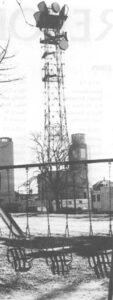During the first six months of 1978, the American people have reacted to the recently perceived health threat posed by microwave and radio frequency radiation with unprecedented vigor and determination. Last April, it was learned that the highest levels of broadcast radiation so far measured by the Environmental Protection Agency in any city in the United States had been found in Portland. A reading of one hundred and fifty microwatts per square centimeter was taken at the base of a radio transmitter tower in Healy Heights, a middle class neighborhood located in the city’s West Hills section, in the midst of a large complex of radio and television transmitting towers.

The residents of Healy Heights were quick to express concern about the possible adverse health effects of such a level of radiation. One hundred and fifty microwatts is, after all, one hundred and fifty times what is considered a safe level of exposure for the general population in the Soviet Union and in other Eastern European countries. It is also a level considerably higher than those shown by American researchers to cause changes in the bioelectric function of the brains of test animals. The fact that there is an unusually high incidence of cancer of the uterus among women who live in the West Hills section of Portland seemingly warrants an immediate and thorough investigation of a possible cause and effect relationship. (The fact that the only two teachers who worked with microwave ovens in a greater Los Angeles high school foods department classroom simultaneously developed cancer of the uterus after only three years of exposure to relatively low levels of microwave radiation should give added impetus to such a study.) In any case, thanks to pressure exerted by the residents of Healy Heights, the hearing examiner of the Portland City Planning Commission recently denied a permit to install a new 365-foot TV transmitter tower on Healy Heights, which would have operated with an effective power output of one million watts. Among other things, the examiner cited the need for better information on the biological effects of low-level radiation, in order to make intelligent decisions about such matters. For their part, the editors of the Willamette Week have sensibly called upon the Portland City Council to seek a lowering of radio frequency power output by stations presently licensed to broadcast from the Healy Heights antenna farm.
Similar reductions in power output may well be in order for other radio and television antenna farms in the United States until such time as studies yet to be performed show that there is no health hazard for people living near them. This seems especially advisable in light of disturbing health situations existing in the vicinity of at least two other such complexes. In the November 1977 issue of the New York State Journal of Medicine, Dr. Robert 0. Becker, a research professor in the Department of Orthopedic Surgery at the Veterans Administration Hospital, in Syracuse, New York, described the results of an informal survey he had taken of the incidence of cancer among eleven hundred people living in the vicinity of a hilltop antenna farm, seven miles south of the city. According to Dr. Becker, the antenna farm contains two TV transmitters, five FM radio transmitters, thirteen microwave relay transmitters, and some power transmission lines. Dr. Becker found that over the past three years there had been seven cases of cancer within this population, and that six of these cases had occurred in two clusters of three each, which were located north of the radio and TV transmitters, and close to the power transmission lines. In his letter to the Journal, Dr. Becker said that the seven cases of cancer were almost double what might have been expected to occur within this population. He went on to say that “the concentration of six of the seven cases in two clusters, within microwave corridors and in the area of increased power transmission radiation, is suggestive of a relationship.” He further suggested that “the results would appear to justify appropriate epidemiological studies of this and similar sites throughout the state.”
Equally disturbing is the situation in Rutherford, New Jersey, where an outbreak of leukemia among children who either attend the Pierrepont Elementary School, or who live in the vicinity, has been determined to be six times the national average and where there also exists an unusual increase in the incidence of Hodgkin’s Disease, which is a cancer of the lymphatic system. When discovery of the cancer cluster in Rutherford was first announced, last April, there was widespread speculation that it might be caused by some chemical contaminant (possibly benzene) in the ambient air or in the drinking water. When this could not be verified, it was pointed out that cancer clusters sometimes occur without explanation, and that such might be the case in Rutherford. Maybe so. It is noteworthy, however, that in the Jersey Meadowlands, just to the east of Rutherford and not far from the school, there is an enormous complex of radio and television transmitter towers. Moreover, officials of the Federal Communications Commission have recently revealed that since the gigantic concrete- and- steel Meadowlands Sports Complex was built, several years ago, radiation patterns broadcast from this antenna farm have been radically altered. The fact that microwaves can cause leukemia was demonstrated in a study conducted by American scientists fifteen years ago, which produced a significant increase in the incidence of leukemia in mice that had been chronically irradiated over a period of one year. At this point, the New Jersey State Department of Environmental Protection is conducting preliminary monitoring of radio frequency and microwave levels in Rutherford.
Additional evidence implicating microwaves as a possible cancer- producing agent comes from North Karelia, a region in Eastern Finland located opposite Lake Ladoga, in the Soviet Union, where the Russian have installed a huge early warning radar system that uses the surface of the lake to reflect and form powerful microwave beams that can be bounced off the ionosphere. As a result of the Soviet radar, the North Karelians are continuously exposed to microwaves in the form of ground waves and scatter radiation. According to a technical report issued by the National Institute for Occupational Safety and Health, in March of this year, an epidemiological study of their health experience, which was conducted by the World Health Organization, shows that since the Soviet radar network became operational, the North Karelians have suffered an unusual increase in the incidences of fatal heart attacks, as well as an unexpected increase in the incidence of cancer.
Congress has so far failed to hold even minimally adequate hearings into the health threat posed by microwaves. However, signals of alarm are being raised which even Congress may soon wish to heed. For example, in April, the General Accounting Office, which is the investigative agency of the Congress, issued a report declaring that the public may already be exposed to dangerous levels of microwave radiation, and that the Federal Government has been negligent in monitoring the problem. In May, the Commerce Department’s National Bureau of Standards warned that the problem of radio waves and microwaves “has been growing rapidly in the last two decades to the point that the skies over our large cities have become literally choked with electromagnetic radiation.” The Bureau went on to say that “long-term subtle consequences possibly involving the nervous system” may be associated with exposure to such radiation. The Bureau also warned that the fifteen million or so CB radios now in use in the United States are contributing significantly to the high levels of radiation to which motorists are being exposed. In light of all this, it is hardly surprising that the National Academy of Sciences’ National Research Council is now proposing to undertake a broad and expensive study of the biological effects of microwaves and other non-ionizing radiation.
In New York City, the Board of Estimate has rejected a proposal by the Coast Guard to construct six microwave towers as part of a harbor-traffic monitoring system, primarily because of public concern over the long-term health effects of microwave radiation. In Boston, a citizens’ group called the Cape Cod Environmental Coalition, Inc., has filed suit in Federal District Court to restrain the Air Force from operating PAVE PAWS -an enormous phased array radar now nearing completion at Otis AFB until it has prepared an environmental impact statement and furnished adequate proof that radiation emanating from the facility will pose no long-term threat to human health. And in dozens of cities and towns across the nation-from La3 Vegas, Nevada, to Bethel, Connecticut-homeowners and other citizens have joined together to oppose the installation of new microwave transmission towers by telephone companies, utility companies, and the Federal Aviation Administration.
On the other hand, heightened public awareness of the microwave health hazard is being more than matched by new schemes for the proliferation of microwaves on the part of government and industry. The National Aeronautics and Space Administration, the Boeing Company, and the Grumman Aerospace Corporation are proposing to develop Satellite Solar Power Stations that will convert the sun’s energy to microwaves and beam them to vast receiving antennas here on earth, where they will then be converted into electricity. The International Civil Aviation Organization has recently voted to require new microwave landing systems at all civil airports by 1995-a project estimated to cost some two billion dollars. And car radars designed to warn drivers of imminent collision are expected to be standard equipment on all automobiles within ten years or so.
In this connection, it is interesting to note that the automobile manufacturers have experienced considerably difficulty in designing electronic sensors, radars, and computers for the new generation of cars, because of electromagnetic interference caused by a myriad of radiation-emitting devices such as the fifteen million CB radios already in use. In fact, the automotive industry, as well as other industries in the United States, have been spending an extraordinary amount of money to shield computers and other electronic equipment from electromagnetic interference. It is perhaps symptomatic of what is wrong with the nation’s priorities in the whole microwave affair. Millions to shield computers, but not a penny to protect the most elegant computer of all-the human brain.
©1978 Paul Brodeur
Paul Brodeur’s Fellowship study is on Microwave Radiation.



